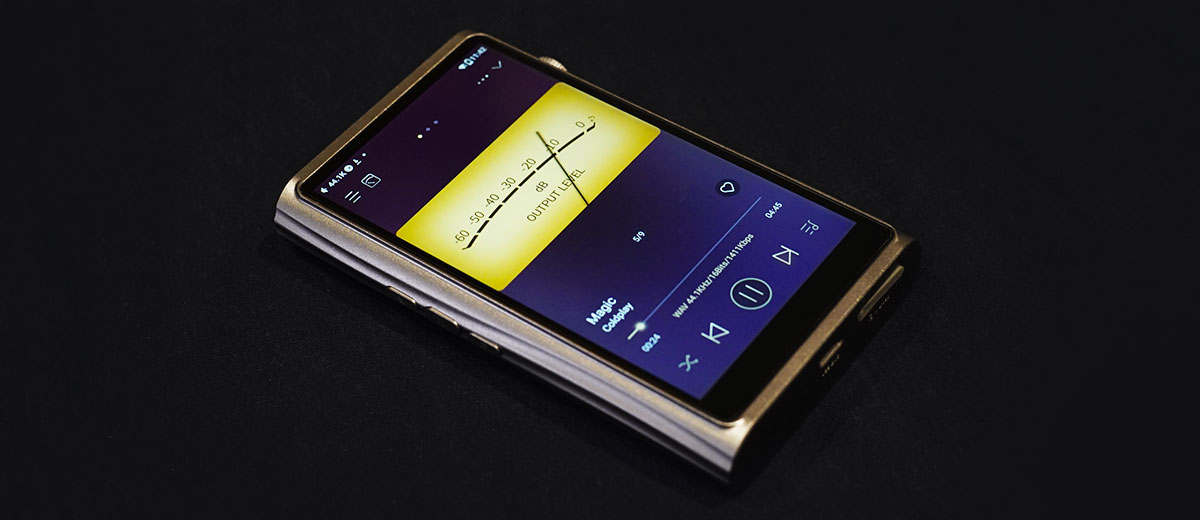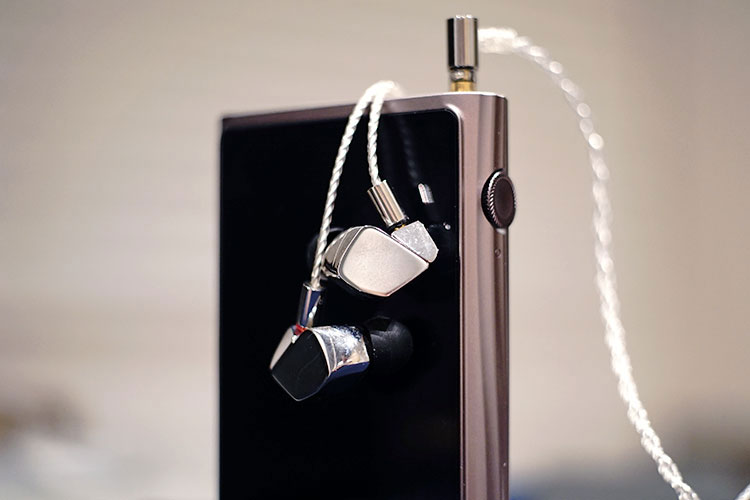Software
Android 10
The M7 is highly responsive with plenty of ROM and a fast controller. Files and general operations are extremely smooth, even when you scroll speedily through a large library.
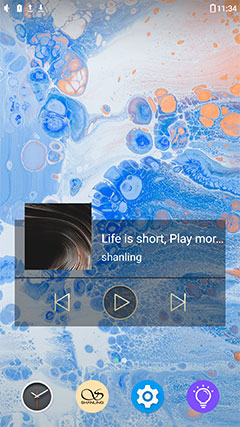
On the open 64bit Android 10 OS you can freely install different APK files, including but not limited to various audio player apps. The software on the M7 is deeply customized with Shanling’s AGLO (Android Global Lossless Output) technology to allow high sampling rates from any apps and are not restricted by Android’s SRC limitations.
You could always check for the latest firmware by pressing the “lightbulb” icon on the bottom bar and updating to the latest firmware, which will solve small bugs and enhance the performance of certain functions from time to time.
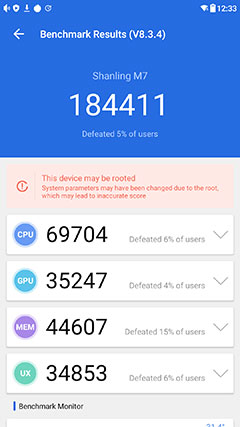
Performance Numbers
Running AnTuTu (v8.3.4) before installing any applications the M7 scores as high as 184411, slightly lower than the M9 which has 2GB more RAM but is a little higher than what is measured on the FiiO M17 and Hiby R8.
Unless you are stressing the machine with intensive graphics, the UI experience is similar to the M9, which is highly responsive and similar to the UI experience on mid-tier phones.

Dropdown Navigation
On the M7, the dropdown menu has been customized to fit in shortcuts for different gain levels. Users could click to enable the audio playback dedicated “Prime mode” that closes other apps and background Android services for better music replay quality and LO mode.
You could put the theme in dark mode giving it a higher contrast under sunlight and by pressing the “pencil” icon on the drag-down menu to customize shortcuts for the function you want to access on the dropdown navigation menu.
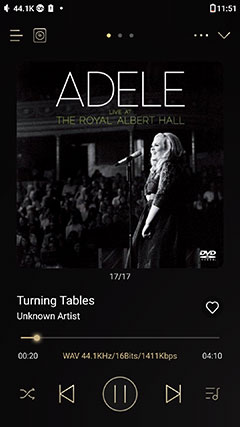
Shanling Music App
Out of the box, you can immediately load your music library and power up the pre-loaded Shanling Music App, the indexing speed is very fast amongst DAPs running on an OS.
With the same customization on the M9, you could scroll swiftly between cover art, and on the playback screen, you could choose to display a VU-meter that will swing with different levels of sound intensity.
The Shanling Music App has other advanced features for example DLNA and SyncLink control that allows users to control the player on a phone or tablet. You can also read your music from your NAS and transfer music via Wi-Fi.
Google Play Support
As far as Google Play Market is concerned, the international version of the M7 is preloaded with Google Play Market. If you prefer to not log into your Google account you can use the CoolApk or APKPure apps on board allowing you to download other applications that might be region locked.
Streaming
With the same controller as on the M9, the M7 supports 16x MQA unfold which means you could enjoy streaming up to 768kHz with Tidal or local MQA files.
The Qualcomm WCN3980 wireless module is employed to support a 2.4/5G Wi-fi Signal with MIMO technology that could ensure a fast and stable connection, also enabling smooth Airplay connection.
Streaming experience and operation on the M7 are as easy as on the phone and the audio quality on balanced output is much superior. When using my phone as a hotspot the output is quite stable without stuttering, and the quality is similar if not better than red book WAV when listening on the go.

Wireless Performance
Wi-Fi Signal Detection
Measuring the M7 and M9 machines 5 meters apart from my AX3000 router with one closed wooden door in between, on the same physical spot the Wi-Fi signal retrieval power is similar.
The speed on both machines is excellent and is sufficient for streaming high-res music or video over WiFi across the living room or to receive a hotspot signal from the phone.
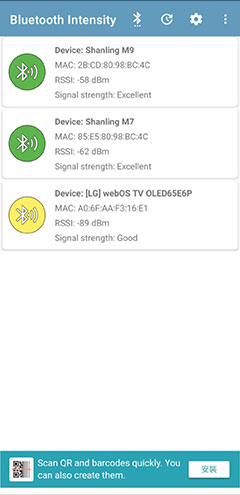
Bluetooth Range
Putting the M9 and M7 2 meters away from my phone as a hotspot and strength meter, using the RSSI (Received Signal Strength Indicator) both M9 and M7 are rated excellent in strength. Both units are able to receive a stable signal over a few meters with just a tiny edge to the M9 in terms of signal strength.
Sound Impressions
Summary
The M7 inherits quite some of M9’s key electronics design and you may discover the tuning qualities alike. Albeit the form factor has put some restriction on its design, the dynamics, as well as separation power, is almost as good.
While the M9 takes the whole frequency range to its limit and has extremely strong transients performance, the M7 is tuned differently in energy distribution, being more even in the highs and lows, and with more seasoning on the mids that brings up the forwardness and sweetness and smoothness.
Bass
Low pitches on the M7 are firm and powerful with a rather fast decay. Testing with the original Top Gun movie, thruster propulsion from F-14’s afterburner takeoff is compelling, it is like you are on the deck of the plane carrier with overwhelmingly strong bass texture and intensity that is literally breathtaking.
When the signature synth bass comes in there is decent airiness and good rumble down low, which helps preserve the tension very well.
In a similar way, the dense and impactful bass with moderately fast speed works well with house music and other synthetic bass instruments, especially on dynamic IEMs.
The soothing airy kicks jack up the dynamics and there is good thickness and boom. Unlike M9’s more accurate and painstakingly firm bass the M7 doesn’t stress on particular frequency ranges, allowing more layering and the sustaining harmonics to be clearly heard.
That said there is plenty of air and layering, and the M7 is able to capture enough power and emotion to sound fun and engaging. At the same time, it renders darker and hoarse voices with good authority and keeps everything in the bass smooth and controlled.
Mids
The mids on the M7 are smoothly articulated and slightly sweetened. The rich bass line has brought up the vocal’s presence, and M7 is balancing it with a gentle dip in the mids, which enhances the articulation and frees up more room in the mid-range frequencies.
Transients in the upper mids are strengthened which gives the M7 some edges for outdoor listening, clearly and cleanly defining the vocal frequencies with the splash of warmth coming from the playful mid-lows.
The fundamental vocal frequencies and their harmonics are well captured while guitars sound wet and swift. Lighter voices on the M7 have a good presence and are rounded gently to not take away its brilliance, taming the sharpness just right for pops and rocks.
The M7 sounds lush with many IEMs. When it comes to exciting, cleanly tuned ones like the final A8000, mid or high gain will further enhance the sharpness and intensity of the vocal, and low gain sounds more controlled and evenly balanced throughout the frequency spectrum.
Testing with classical music, there is substantial weight and impact to bring out the momentum and energy in fast, fortissimo bowing and loud piano chords, with the overtones elegantly rendered.
For example, Freddie Mercury’s voice with beautiful subharmonics is a pleasure to listen to on the M7 with dynamic IEMs in particular, that have the resolving power to capture the midrange frequencies smoothly.
Treble
The treble on the M7 nicely complements the lower frequencies. It preserves good air and allows overtones to ride on smooth, with cleanly presented vocals and strings.
The vocal penetrates well with light upper order harmonics adding some definition. That again doesn’t mean that it sounds very bright and sharp, but delicately polished to not go over the edge. That allows the M7 to pair with some analytical-sounding IEMs and still remain natural sounding.
With Shanling’s powerful and fast OP+BUF configuration the M7 sounds very responsive, intense, and textured. This is different from M9’s HiFi direction, and more towards smoothness and naturalness.
Staging & Dynamics
The soundstage on the M7 is moderately large as there is plenty of power to open it up. The energetic bassline brings forward drums and acoustic instruments while the good presence of overtones helps to define better the space render.
If you are comparing to the M9 side by side you will notice it doesn’t handle a large ensemble as effortlessly as the M9, giving each instrument in the mix a wider image that colors the output less “Hifi” but more relaxing.
Using Black Sabbath’s Paranoid to test, the guitar feels just a few rows away yet it is very intense and wet. You can feel the similar sweetness in the vocal that is full-bodied imaged and distinctly positioned a few rows in front.
The bass and treble intensity is nicely balanced on the M7 such that it doesn’t feel leaned to either side, and there is excellent coherence between different elements in the mix which are mixed beautifully in the rendered headroom.
In short, the M7 presents small gigs dynamically and livelily in a naturally rendered, hall-sized stage. There is good openness and with most IEMs there is no need to tweak the equalizer to sound balanced.
I don’t feel any frequencies missing or any uneasiness and the balanced output on the M7 feels rather accurate to the original record compared to my calibrated Genelec monitors.

